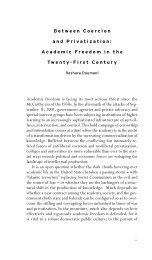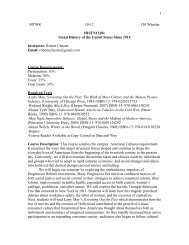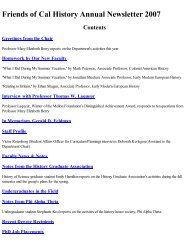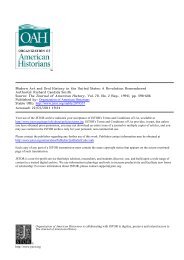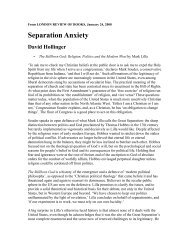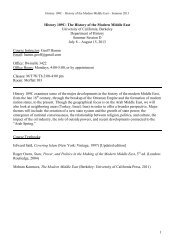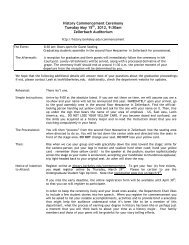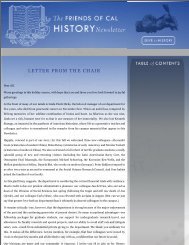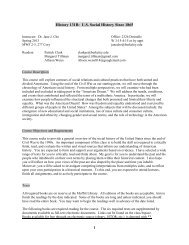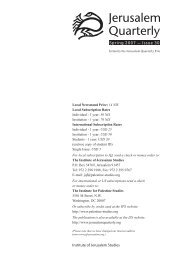often received as a scurrilous attack on Jefferson's honor. Tellers of the Jefferson-Hemings story nowexplore more readily the possibility that the relationship was a tender <strong>and</strong> loving one, <strong>and</strong> sometimesimply that the relationship, despite the horrors of slavery, illustrates the way in which American societyis a single, extended family. 36 One journalist after another takes as a harbinger for the nation'sdemographic <strong>and</strong> ideological future the determination of the popular golf champion Tiger Woods toaffirm all aspects of his multiple ancestry, including black, white, Indian, Chinese, <strong>and</strong> Thai. 37Oprah Winfrey proclaimed the mixed-descent Woods to be "America's son" in a construction that 21invites a comparison between what Woods' "family tree" might look like <strong>and</strong> the family tree of another"America's son," the one drawn by Norman Rockwell at about the time of Hannah Arendt's imbrogliowith Commentary <strong>and</strong> the Lovings' arrest in Virginia. Rockwell's "Family Tree," offered as theSaturday Evening Post cover for October 24, 1959, is defined by a preoccupation with degrees ofrespectability <strong>and</strong> with Union-Confederate reconciliation, not by the mixing of ethnoracial groups. (SeeFigure 1.) Rockwell shows the stylized, Ozzie-<strong>and</strong>-Harriet era white child to be the descendant of,among other characters, a colonial-era pirate <strong>and</strong> frontier-based "Squaw man" <strong>and</strong> their mates. <strong>The</strong>re isno black face on the tree, but Rockwell invites beholders, while chuckling at their culture's tendency forgenealogical aggr<strong>and</strong>izement, to be comfortable with the Indian woman in the Anglo child's genealogy,as well as with the presence there of a proto-Latina in the person of the pirate's mate. 38 <strong>The</strong> whitenessof the cherubic little boy at the top of the painting filters visually down the tree—<strong>and</strong> back throughAmerican history—to cover all the people Rockwell admits into the company of begetters <strong>and</strong> begotten.<strong>The</strong> men whose social marginality is marked by their non-Anglo mates are thus recognized in the familytree of the white 1950s, as are even the slightly darker women who coupled with the one-eyed pirate<strong>and</strong> the scruffy frontiersman. Rockwell's "Family Tree" is a super-Anglo picture of the Americanpopulation, in which tiny quantities of Hispanic <strong>and</strong> Indian descent are feminized, located in a distantpast, <strong>and</strong> diluted to the point of non-recognition in Rockwell's white present. Had Rockwell been moreconcerned to display an ethnoracially marked melting pot, he might well have rendered some of themore swarthy figures in the picture easily recognized as non-Anglo European immigrants. But theevident lack of such an intent on Rockwell's part renders his inclusion of the Indian <strong>and</strong> thesenorita/senora all the more revealingly incidental. It was inconceivable that Rockwell would haveencouraged the white readers of the Saturday Evening Post in 1959 to suppose that a black personmight be among their ancestors, but it was not a stretch to get Indians <strong>and</strong> Latinos into the mix.Figure 1: "Family Tree" by Norman Rockwell. Copyright 1959SEPS: licensed by Curtis Publishing, Indianapolis, Indiana. Allrights reserved. www.curtispublishing.com.
But the ancestry of Tiger Woods also includes Chinese <strong>and</strong> Thai. Woods' partly Asian ancestry can 22direct us to one of the circumstances that have promoted the extraordinary new display of interest in thequestion of ethnoracial mixture in our own time <strong>and</strong> can turn us, also, to dimensions of the questioninvolving Americans of Asian <strong>and</strong> Latin American descent.Massive immigration from Asia <strong>and</strong> Latin America since about 1970 has radically altered the 23ethnoracial composition of the United States, has produced new kinds of mixtures, <strong>and</strong> by enactingsocially recognized mixture on a large scale has made some African Americans all the more cognizantof the invidious character of the one-drop rule for black identity. 39 We get a sense of the magnitude ofthis new migration if we contemplate the fact that the number of non-black immigrants between 1970<strong>and</strong> 2000 who are also non-Europeans roughly equals the number of African Americans already residentin the United States in 1980, about 26 million. Another 9 million non-black immigrants entered theUnited States during the same three decades, especially from Russia, Ukraine, Pol<strong>and</strong>, <strong>and</strong> Iran (a"Middle Eastern" rather than an "Asian" country by popular reckoning), but the Asian <strong>and</strong> LatinAmerican migrations were the most relevant to our question. Each of these two cases had features thatdistinguished it from the other, <strong>and</strong> from the African-American case to which both are often compared.Immigrants from Asia were entering a country with only a tiny number of preexisting Asian 24Americans—there were only about a million <strong>and</strong> a half at the time of the Celler Act in 1965, well under1 percent of the population—yet a country with a history of anti-Asian prejudice that in some respectsran parallel to anti-black prejudice, even legally, <strong>and</strong> in other respects did not. <strong>The</strong> Chinese ExclusionAct of 1882 was the first nationally or ethnoracially group-specific restriction on immigration, <strong>and</strong>Asian immigrants generally remained ineligible to become naturalized citizens until 1952, whenCongress finally abolished the white-only principle for naturalization that had been in place since 1790<strong>and</strong> that courts had subsequently construed to apply to immigrants from India as well from East Asia. 40Asians were never constitutionally enslaved, nor were they lynched in large numbers in the twentiethcentury, but some of the miscegenation statutes listed "Oriental" or "Mongolian" along with "Negro." 41In southern states, this followed less from the presence of Asian ethnics—there were almost none inmost southern states—than from doctrinal consistency.Only in a few western states, especially California, was the prohibition of marriages between whites 25<strong>and</strong> Asians a serious project. Yet even California's miscegenation statute had been ruledunconstitutional by that state's own supreme court in 1948, nearly twenty years before Loving v.Virginia <strong>and</strong> even more distant from the new wave of immigrants from China, Korea, Vietnam, India,<strong>and</strong> other Asian nations that began to appear. By the time of that immigration, moreover, most whiteAmericans who had an opinion about Japanese internment during World War II, the most notoriousenactment of anti-Asian prejudice in popular memory, regarded that internment as a dreadful mistake,deserving even of reparations, which were in fact eventually paid. 42Hence the new immigrants from Asia were entering the country at a time when anti-Asian prejudice 26was in decline <strong>and</strong> when restrictions on Asian-white marriages were a distant memory in the parts ofthe country where most Asians had been living <strong>and</strong> where most of the new immigrants settled. <strong>The</strong>secircumstances—taken together with the fact that many of the new immigrants from Asia had vibrantinternational kinship networks <strong>and</strong> marketable skills that quickly translated into strong class position—help explain the rapid incorporation of Asian ethnics into American society, even as measured byintermarriage. In the 1990 census, about half of the Asian Americans who had been born in the UnitedStates <strong>and</strong> were then getting married were acquiring non-Asian spouses. 43 <strong>The</strong> high rate of Asian-whitemarriage blurs the line between these two descent communities, <strong>and</strong> thus speaks to the question of



